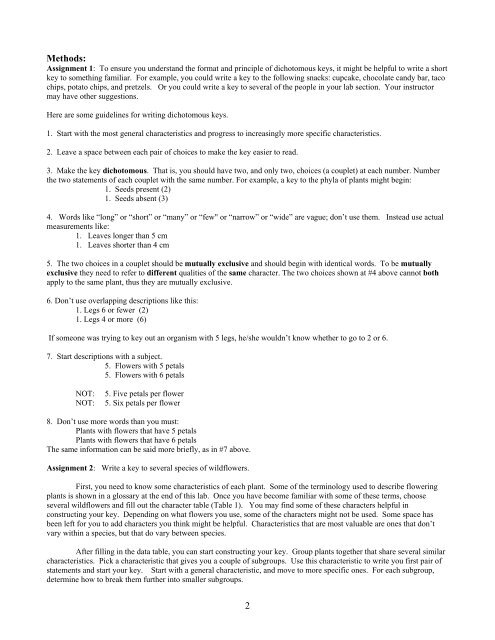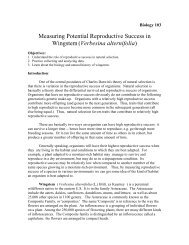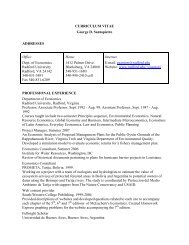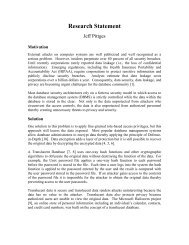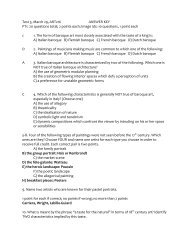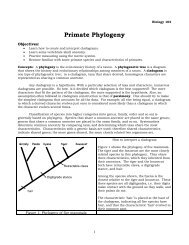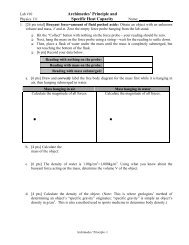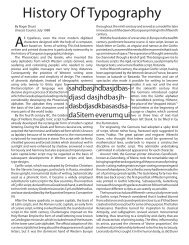Writing a Dichotomous Key to Wildflowers
Writing a Dichotomous Key to Wildflowers
Writing a Dichotomous Key to Wildflowers
Create successful ePaper yourself
Turn your PDF publications into a flip-book with our unique Google optimized e-Paper software.
Methods:<br />
Assignment 1: To ensure you understand the format and principle of dicho<strong>to</strong>mous keys, it might be helpful <strong>to</strong> write a short<br />
key <strong>to</strong> something familiar. For example, you could write a key <strong>to</strong> the following snacks: cupcake, chocolate candy bar, taco<br />
chips, pota<strong>to</strong> chips, and pretzels. Or you could write a key <strong>to</strong> several of the people in your lab section. Your instruc<strong>to</strong>r<br />
may have other suggestions.<br />
Here are some guidelines for writing dicho<strong>to</strong>mous keys.<br />
1. Start with the most general characteristics and progress <strong>to</strong> increasingly more specific characteristics.<br />
2. Leave a space between each pair of choices <strong>to</strong> make the key easier <strong>to</strong> read.<br />
3. Make the key dicho<strong>to</strong>mous. That is, you should have two, and only two, choices (a couplet) at each number. Number<br />
the two statements of each couplet with the same number. For example, a key <strong>to</strong> the phyla of plants might begin:<br />
1. Seeds present (2)<br />
1. Seeds absent (3)<br />
4. Words like “long” or “short” or “many” or “few" or “narrow” or “wide” are vague; don’t use them. Instead use actual<br />
measurements like:<br />
1. Leaves longer than 5 cm<br />
1. Leaves shorter than 4 cm<br />
5. The two choices in a couplet should be mutually exclusive and should begin with identical words. To be mutually<br />
exclusive they need <strong>to</strong> refer <strong>to</strong> different qualities of the same character. The two choices shown at #4 above cannot both<br />
apply <strong>to</strong> the same plant, thus they are mutually exclusive.<br />
6. Don’t use overlapping descriptions like this:<br />
1. Legs 6 or fewer (2)<br />
1. Legs 4 or more (6)<br />
If someone was trying <strong>to</strong> key out an organism with 5 legs, he/she wouldn’t know whether <strong>to</strong> go <strong>to</strong> 2 or 6.<br />
7. Start descriptions with a subject.<br />
5. Flowers with 5 petals<br />
5. Flowers with 6 petals<br />
NOT:<br />
NOT:<br />
5. Five petals per flower<br />
5. Six petals per flower<br />
8. Don’t use more words than you must:<br />
Plants with flowers that have 5 petals<br />
Plants with flowers that have 6 petals<br />
The same information can be said more briefly, as in #7 above.<br />
Assignment 2: Write a key <strong>to</strong> several species of wildflowers.<br />
First, you need <strong>to</strong> know some characteristics of each plant. Some of the terminology used <strong>to</strong> describe flowering<br />
plants is shown in a glossary at the end of this lab. Once you have become familiar with some of these terms, choose<br />
several wildflowers and fill out the character table (Table 1). You may find some of these characters helpful in<br />
constructing your key. Depending on what flowers you use, some of the characters might not be used. Some space has<br />
been left for you <strong>to</strong> add characters you think might be helpful. Characteristics that are most valuable are ones that don’t<br />
vary within a species, but that do vary between species.<br />
After filling in the data table, you can start constructing your key. Group plants <strong>to</strong>gether that share several similar<br />
characteristics. Pick a characteristic that gives you a couple of subgroups. Use this characteristic <strong>to</strong> write you first pair of<br />
statements and start your key. Start with a general characteristic, and move <strong>to</strong> more specific ones. For each subgroup,<br />
determine how <strong>to</strong> break them further in<strong>to</strong> smaller subgroups.<br />
2


